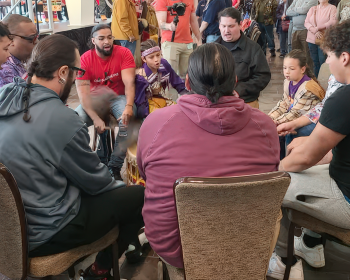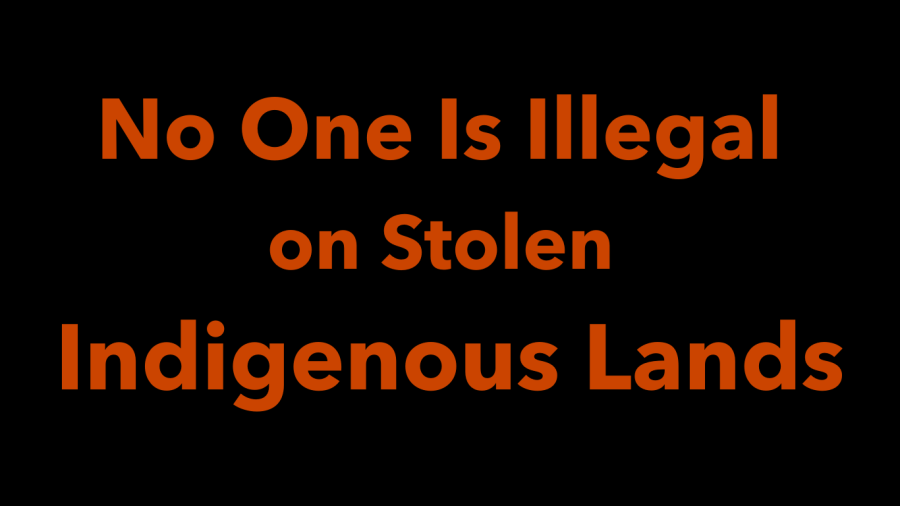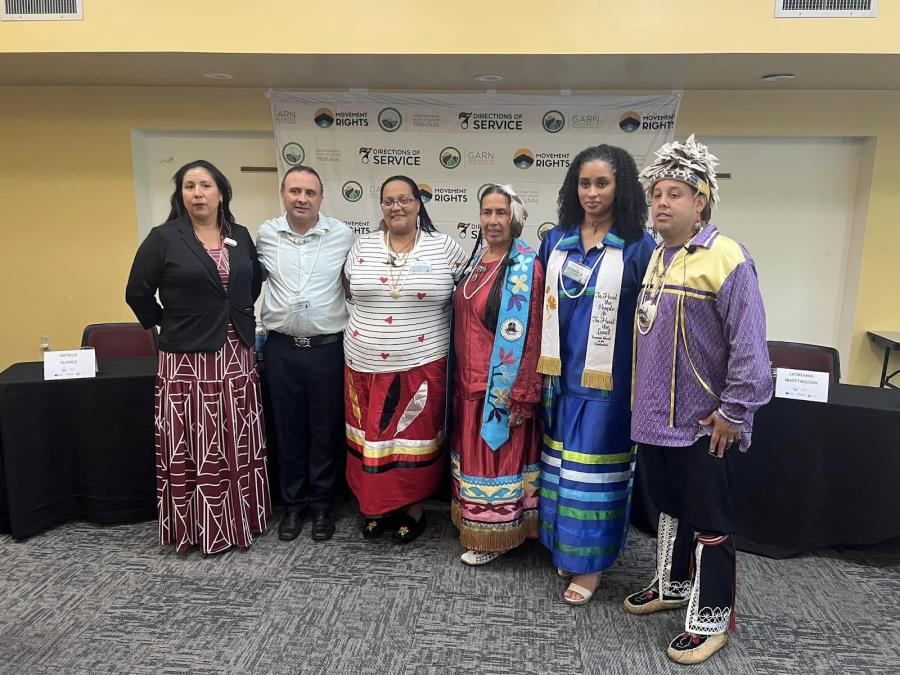Every year tens of thousands of Alaska Natives harvest, process, distribute, and consume millions of pounds of wild animals, fish, and plants through an economy and way of life that has come to be termed `subsistence.' Collectively, these varied subsistence activities constitute a way of being and relating to the world, and thus comprise an essential component of Alaska Native identities and cultures. Most Alaskans, Native and nonNative alike, would like to see customary and traditional subsistence activities continue, but it is clear that they cannot endure without legal protections. While some safeguards to subsistence have been passed through federal and state laws, many challenges remain in the effort to chart an effective subsistence policy for Alaska Native peoples.
When Alaska's oil development boomed in the late 1960s, one big kink in the proposed pipeline connecting the state's oilrich North Slope with the Gulf ofAlaska was Native land and user rights. The `Native issue' had to besettled before large-scale industrial development could proceed. Itwas in this charged atmosphere that the landmark Alaska Native Claims Settlement Act (ANCSA) of 1971 was hurriedly passedthrough the U.S. Congress. Amixture of assimilation and self-determination elements, this major piece of social engineering legislation has profoundly affected Alaska Native tribes.
On one hand, ANCSA created 13 regional and more than 200 village corporations, gave these for-profit entities title to 10% of the state's lands, and compensated them $3 an acre for other lands taken (nearly a billion dollars total). On the other hand, Congress extinguished all aboriginal hunting and fishing rights as part of the settlement and in return, both the Secretary of Interior and the State of Alaska would "take any action necessary to protect the subsistence needs of the Natives."
For Alaska Natives, including Aleuts, Athabascans, Alutiiqs, Haidas, Inupiat and Yup'ik Eskimos, Tlingits, Tsimshians and other groups, this expectation has not been met. Twenty-five years after ANCSA, and despite passing the state and federal subsistence statutes, Alaska's subsistence policy remains mired in politics pitting state vs. federal governments, rural vs. urban residents, and most unfortunately, Natives vs. non-Natives. Although Alaska's subsistence laws may be unique, the forces that threaten indigenous peoples' subsistence in the state-industrial development, competition, cultural insensitivity and hegemony, and political marginalization-are similar to those affecting Native peoples' livelihoods the world over. Because a sound subsistence policy is vital to the health and cultural survival of Alaska Natives, the issue merits special attention. The future of Alaska Natives hangs in the balance.
The Historical and Legal Framework for Subsistence
Although various minor provisions for subsistence existed in Alaska laws and regulations prior to 1971, as a result of the ANCSA, both the state and the federal governments passed major subsistence legislation. The first state law, enacted in 1978, gave priority to subsistence uses of wild, renewable resources over other consumptive uses (such as recreational hunting and commercial fishing) but failed to define `users.' The federal law (Title VIII of the Alaska National Interest Lands Conservation Act, or ANILCA), passed in 1980, also mandated a subsistence priority, but in addition, defined an allocation preference for rural Alaskans in times of scarcity. This did not mean that urban residents did not need or could not obtain wild resources, but merely that rural residents' needs would be met first if there were shortages.
The rural preference resulted from a political compromise designed to protect Native subsistence, in keeping with Congress' intent in ANCSA, while not discriminating on the basis of ethnicity -- something powerful non-Native interests in the state vigorously opposed. Some advocacy groups representing the urban hunters and fishers also viewed the rural preference as unfair and unconstitutional and fought state efforts to comply with this federal mandate. Although a rural preference was finally added to the state statute in 1986, it soon was declared unconstitutional by the Alaska Supreme Court in its 1989 McDowell decision. This left the state without an effective tool for distinguishing subsistence users from other groups (see W. Simeone's article in this issue).
The state's failure to achieve a rural preference put it out of compliance with the federal subsistence law and set the stage for a federal takeover of subsistence hunting and fishing in Alaska. In 1990, a dual management structure commenced with the federal government regulating subsistence on federal lands (60% of the state) and the state retaining authority over state (30%) and private (10%) lands. Significantly, the state maintained control of navigable waters, a source of valuable commercial salmon and subsistence fish, as part of a political compromise. Since 1990, three state governors, eight regular legislatures, three special legislative sessions on the issue, and a host of task forces, mediators, and other initiatives have all failed to resolve the subsistence impasse.
Most recently, in June 1998, a special session of the state legislature -- dominated by conservative, urban lawmakers -- rejected a constitutional amendment allowing for a rural preference. Meanwhile, the federal government is reluctantly preparing to take over management of subsistence fishing on December 1, 1998. This is ironic, as one of the driving forces of Alaska statehood was state control over its fish and game and ANILCA was crafted specifically to accommodate the state and avoid the waste and complexity of dual management by yielding management authority on federal lands to the state. Most Alaska Native groups also initially supported state management and have embraced federal management only in the wake of the state's repeated failures to protect their subsistence needs.
Although federal management may bring better protection to Native subsistence activities in the short run, it is a fragile solution. We can expect that the state will unceasingly carry on in its effort to regain control of fish and game. And if the state succeeds in this effort by amending its constitution or by some other means, the historical record suggests we should be concerned about its commitment to provide rural Alaskans-Alaska Natives in particular-with a subsistence priority and meaningful role in fish and wildlife management. In the meantime, indigenous groups will continue to seek greater sovereignty and self-determination and do whatever it takes to sustain their families, customs, and traditions. Given these stakes and competing interests, it is likely that subsistence will remain a highly charged issue in the future.
Underlying Cultural, Economic, and Trust Issues
Alaska Department of Fish and Game (ADF&G) studies show that rural subsistence accounts for only 4% of the total fish and wildlife harvest, while 95% goes to commercial interests and 1% to sport users. Looking at these figures, one might wonder why there is such a fuss over such a tiny slice of the resource pie. What these statistics don't reveal, however, is the constellation of cultural, economic, and trust issues that underlie subsistence and often complicate the issue in polarizing ways. It is worth examining some of these key issues in detail.
The Cultural Issue
Federal and state laws do not define the term subsistence directly, only the phrase `subsistence uses.' But ANILCA distinguishes Native subsistence as something exceptional and cultural, noting that "the opportunity for subsistence uses by rural residents of Alaska...is essential to Native physical, economic, traditional, and cultural existence and to nonNative physical, economic, traditional, and social existence." Although the distinction seems minor, it betrays a deeper philosophical division between Native and non-Native conceptions of subsistence.
Alaska Natives typically define subsistence more fundamentally than non-Natives. For most Natives, subsistence is synonymous with culture, identity, and self-determination. As Nelson Frank, a Haida from southeast Alaska put it in his testimony before the Alaska Native Review Commission (recorded in the book Village Journey by Thomas Berger):
"Subsistence living, a marginal way of life to most, has no such connotation to the Native people of southeast Alaska. The relationship between the Native population and the resources of the land and the sea is so close that an entire culture is reflected...Traditional law...was passed from generation to generation, intact, through repetition of legends and observance of ceremonials which were largely concerned with the use of land, water, and the resources contained therein. Subsistence living was not only a way of life, but also a life-enriching process. Conservation and perpetuation of subsistence resources was part of that life and was mandated by traditional law and custom."
Because Alaska Native groups continue to define themselves to a large degree by the customs and traditions in obtaining, processing, and distributing wild resources, they see the maintenance of these cultural traditions and laws as an essential element of their subsistence. As the landmark 1989 federal court decision in Bobby v. Alaska shows (see W. Caldwell's article in this issue), Native customary and traditional practices are protected by ANILCA and cannot be arbitrarily overridden by state fish and game regulations.
While Natives' definitions of subsistence tend to be broad and holistic, embodying a wide range of customs and traditions, non-Native conceptions are typically more restrictive. Many adhere to a popular dictionary definition of subsistence as "the minimum [food and shelter] necessary to support life," thus concluding that only those "who really need it" should be given a priority as subsistence users. This is sometimes referred to as the `subsistence-as-welfare' concept, because of its emphasis on poverty and economic need. Given the negative associations of this image, it is no wonder that many non-Native Alaskans, whose rural residence qualifies them as subsistence users under the law, categorically reject the subsistence label in favor of terms like `personal use.'
Obviously, the notion of subsistence as welfare represents the very antithesis of the Native point of view and has no basis in current law. As Inupiat leader Eileen MacLean put it: "Subsistence is not about poverty; it is about wealth. This wealth is expressed in the harvest and in the sharing and celebration that result from the harvest." Yet, the popular misconception unfortunately endures.
Part of the problem may lie with the term subsistence itself. Perhaps no single term can convey the countless customs and values that are embedded in subsistence. Aware of its limits, Alaska Natives have also tried to replace it. One effort undertaken in this regard involved identifying phrases in Alaska Native languages that embody the cultural aspects of subsistence (see C. Alexander interview in this issue). Several of these phrases were translated as `our way of life' or `our way of being,' reflecting the holistic and essential Native vision of subsistence. (Interestingly, `real being' is a legitimate English definition of the word subsistence, though not the most common interpretation.)
In the end, however, more than terminology, it is the conflicting cultural visions -- a Native one based on cultural identity, customs, and traditional values, and a non-Native one based on individual rights and economic need -- that continue to polarize the subsistence debate.
The Economic Issue
Misconceptions about the economics of subsistence also tend to divide constituents on the issue. One myth is that subsistence is merely a lifestyle choice or a rural necessity and not a significant sector of the Alaskan economy. This too is false. While recreational and commercial users take the lion's share of fish and wildlife, subsistence economies show high levels of participation and production. For example, 92-100% of surveyed households in rural Alaska use wild fish and 75-98% harvest fish. Given Alaska's rural population of 116,653 (21% of the total population, 48% of which is Native), subsistence is by far the state's largest employer. Moreover, annual fish, wildlife, and plant harvests among rural Alaskans average 375 pounds per person, or about a pound a day, versus 22 pounds per person per year in urban areas. Subsistence is a critical sector of Alaska rural economies.
In addition to providing essential nutrition and gainful employment, subsistence contributes valued products to the economy that would cost some $200-400 million to replace. And this estimate is based on replacement food value alone, leaving aside the incalculable cultural values embodied in subsistence.
A second, more pernicious misconception is that a subsistence priority over other consumptive uses will somehow throw a wrench into the `real' (i.e., cash-based) economies that depend on fish and wildlife, such as the commercial fishing and guided hunting industries. Motivated by this fear and a drive to maximize their share of the resources, commercial interests have lobbied hard to weaken the subsistence priority provisions in both state and federal law. But thus far, the subsistence priority has not posed the slightest threat to the commercial economy, even under federal management.
The Trust Issue: "Indian Law," Not Just an Allocation Scheme
Some non-Native recreational interests oppose subsistence on the grounds that no preferences should be conferred on the basis of ethnicity, community of residence, or other group criteria. They hold that any allocation scheme should be based on individual criteria, such as income or historical dependence. While this is attractive in principle, it ignores two key characteristics of Alaska Native subsistence. The first is the communal character of Native subsistence economies which display, among other things, widespread sharing among individuals and households. Individualizing eligibility would undermine the social economy of redistribution and other communal attributes of subsistence and, at worst, turn it into the kind of welfare system everyone despises.
The second is that Alaska Native subsistence rights are a federal trust responsibility. Congress expressed its concern and intent to safeguard Native subsistence rights in ANCSA, and ANILCA was the result of that mandate. To this extent, ANILCA is Indian law, regardless of the "rural preference" compromise. To suggest otherwise is to distort the legislative history of Congress and the special status of American Indian tribes within the U.S. If ANILCA were somehow repealed or nullified, it is clear that the Secretary of the Interior would still have the authority to enforce a Native-only subsistence priority based on his legal responsibilities to protect the welfare of Alaska Natives. It was this trust responsibility that led Congress to grant Alaska Natives a subsistence priority (literally an exemption from a ban on hunting certain sea mammals) in the Marine Mammal Protection Act of 1972. While a Native priority might not be politically feasible for other fish and wildlife resources, any changes in the federal subsistence law will have to provide satisfactory protections for Alaska Natives.
A New Era for Subsistence?
Subsistence lifestyles are time-honored, largely self-regulating traditions among Alaska Natives. Most Alaskans agree that subsistence uses should take priority over other consumptive uses of wild resources when supplies are limited. But disagreements abound over the meaning of subsistence, who should qualify for it, and how to manage it, which have proved major stumbling blocks in maintaining effective public policy. Most Alaska Native groups accept the rural preference and "customary and traditional" subsistence use provisions of ANILCA as a workable means of protecting their subsistence interests. Sadly, however, these provisions remain under constant attack, and even if they are not weakened politically, Native subsistence protections under the rural preference seem doomed to demographic dilution, as the state's non-Native rural population continues to grow.
To be an effective public policy, subsistence must not be viewed simply as an allocation scheme or as the preservation of archaic lifestyles in a changing world. Rather it should be understood as a means of sustaining and promoting healthy relationships between communities and their land and resource bases -- a "life-enriching process" as Nelson Frank puts it. Though rooted in the past, subsistence is dynamic and varied, adapting by necessity to changing technological, demographic, and socioeconomic circumstances. A viable subsistence policy must recognize this dynamism and diversity and construct a regulatory process that is responsive to these variables. Alaska Natives must play a meaningful role in managing their own subsistence, and a truly cooperative spirit must pervade all aspects of management, including research, policy formation, and implementation. Some promising co-management models already exist (see C. Brower and T. Hepa's discussion of the Alaska Eskimo Whaling Commission, or J. Fall and M. Chythlook's discussion of Round Island walrus hunting in this issue), and fortunately, it is not too late to develop others. For Alaska Natives, it is a matter of cultural survival.
Further Reading
Berger, Thomas R. 1985. Village Journey: The Report of the Alaska Native Review Commission. New York: Hill and Wang.
Case, David S. 1992. "Subsistence and Self-Determination: Can Alaska Natives Have a More Effective Voice?" University of Colorado Law Review. 60(4): 1009-35.
Kancewick, Mary and Eric Smith. 1991. "Subsistence in Alaska: Towards a Native Priority." UMKC Law Review. Vol. 59(3):645-677.
Langdon, Steve J. 1986. Contemporary Alaskan Native Economies. New York: University Press of America.
Tundra Times Special Subsistence Issue. 1996. Volume XXV, No. 18, June 19, 1996.
Wolfe, Robert J. and Robert J. Walker. 1987. "Subsistence Economies in Alaska: Productivity, Geography, and Development Impacts." Arctic Anthropology. Vol. 24(2):56-81.
Article copyright Cultural Survival, Inc.



